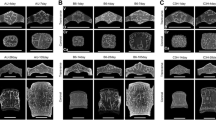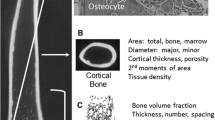Abstract
The relationship between bone quality and strength was studied in 11 BXH recombinant inbred (RI) strains of mice. The bone quality parameters studied were bone mineralization, microhardness, architecture, and connectivity. Previous studies have demonstrated considerable variability in bone density, biomechanical properties, and microstructure among inbred strains of mice. In particular, C3H/HeJ (C3H) mice exhibit thicker femoral and vertebral cortices and fewer trabeculae in the vertebral body compared with C57BL/6J (B6) mice, despite having similar vertebral bone strength. A set of RI mouse strains has been generated from B6 and C3H (denoted BXH) in an attempt to isolate genetic regulation of numerous traits, including bone. The objective of this study was to investigate relationships among bone quality and bone strength in femurs and vertebrae among BXH RI mice. The study involved 11 BXH RI strains of female mice (n = 5−7) as well as the B6 and C3H progenitor strains. Parameters contributing to bone quality were evaluated, including BMD, bone mineralization, microhardness, architecture, and connectivity. There was a strong correlation between femoral and vertebral BMD in all strains (P < 0.001) except in BXH-9 and -10 (P < 0.001). Within the vertebrae, cortical bone was more mineralized than trabecular bone, and a strong correlation existed between the two (P < 0.001). However, cortical microhardness did not differ from trabecular microhardness. Cortical bone was more mineralized in the femur than in the vertebrae and significantly harder, by 30%. There was a wide range in trabecular connectivity, architecture, and femur geometry among BXH RI strains. BMD explained 43% of vertebral bone strength but only 11% of femoral bone strength. Trabecular connectivity explained an additional 8% of vertebral strength, while mineralization and femur geometry explained 7% and 50% of femoral strength, respectively. Different bone quality parameters had varying influences on bone mechanical properties, depending on bone site. BMD may play a larger role in explaining bone strength in the vertebrae than in the femur. Moreover, cortical bone in the femur is harder than in vertebrae. The control of cortical bone material properties may be site-dependent.




Similar content being viewed by others
References
McKay HA, Bailey DA, Wilkinson AA, et al. (1994) Familial comparison of bone mineral density at the proximal femur and lumbar spine. Bone Miner 24:95–107
Pocock NA, Eisman JA, Hopper JL, et al. (1987) Genetic determinants of bone mass in adults: a twin study. J Clin Invest 80:706–710
Beamer WG, Donahue LR, Rosen CJ, Baylink DJ (1996) Genetic variability in adult bone density among inbred strains of mice. Bone 18:397–403
Taylor BA (1979) Established and incipient recombinant inbred strains of mice. In: Green MC (ed), Genetic Variants and Strains of the Laboratory Mice. Fischer, Stuttgart, p 397
Turner CH, Hsieh Y, Muller R, et al. (2000) Genetic regulation of cortical and trabecular bone strength and microstructure in inbred strains of mice. J Bone Miner Res 15:1126–1131
Turner CH, Hsieh Y, Muller R, et al. (2001) Variation in bone biomechanical properties, microstructure, and density in BXH recombinant inbred mice. J Bone Miner Res 16:206–213
Nagy TR, Prince CW, Li J (2001) Validation of peripheral dual-energy X-ray absorptiometry for the measurement of bone mineral in intact and excised long bones of rats. J Bone Miner Res 16:1682–1687
Schenk RK, Olah AJ, Herrmann W (1984) Preparation of calcified tissues for light microscopy. In: Dickson GR (ed), Methods of Calcified Tissue Preparation. Elsevier, New York, pp 24–40
Parfitt AM, Drezner MK, Glorieux FH, et al. (1987) Bone histomorphometry: standardization of nomenclature, symbols, and units. J Bone Miner Res 10:149–156
Garrahan NJ, Mellish RW, Compston JE (1986) A new method for the two-dimensional analysis of bone structure in human iliac crest biopsies. J Microsc 142:341–349
Bracci PM, Bull SB, Grynpas MD (1988) Analysis of compositional bone density data using log ratio transformations. Biometrics 54:337–349
Currey JD (1990) Physical characteristics affecting the tensile failure properties of compact bone. J Biomech 23:837–844
Beamer WG, Shultz KL, Donahue LR, et al. (2001) Quantitative trait loci for femoral and lumber vertebral bone mineral density in C57BL/6J and C3H/HeJ inbred strains of mice. J Bone Miner Res 16:1195–1206
Bouxsein ML, Uchiyama T, Rosen CJ, et al. (2004) Mapping quantitative trait loci for vertebral trabecular bone volume fraction and microarchitecture in mice. J Bone Miner Res 19:587–600
Judex S, Garman R, Squire M, et al. (2004) Genetically based influences on the site-specific regulation of trabecular and cortical bone morphology. J Bone Miner Res 19:600–606
Sheng MH, Baylink DJ, Beamer WG, et al. (2002) Regulation of bone volume is different in the metaphyses of the femur and vertebra of C3H/HeJ and C57BL/6J mice. Bone 30:486–491
Acknowledgement
The authors thank Dr. Mircea Dumitriu for his assistance with image analysis, Douglas Holmyard for his assistance with BSE microscopy, and Dr. Robert Parks for his expertise in statistical analysis.
Author information
Authors and Affiliations
Corresponding author
Rights and permissions
About this article
Cite this article
Ng, A.H.M., Wang, S.X., Turner, C.H. et al. Bone Quality and Bone Strength in BXH Recombinant Inbred Mice. Calcif Tissue Int 81, 215–223 (2007). https://doi.org/10.1007/s00223-007-9047-8
Received:
Accepted:
Published:
Issue Date:
DOI: https://doi.org/10.1007/s00223-007-9047-8




